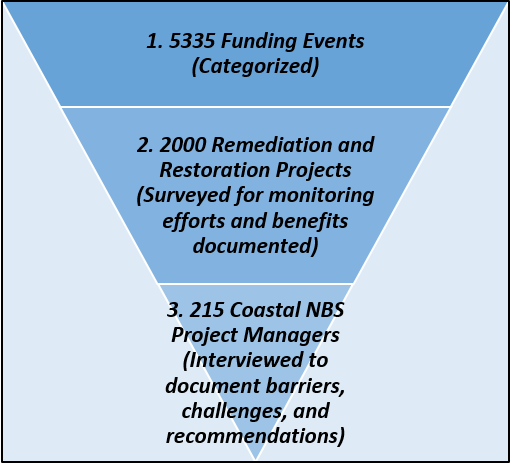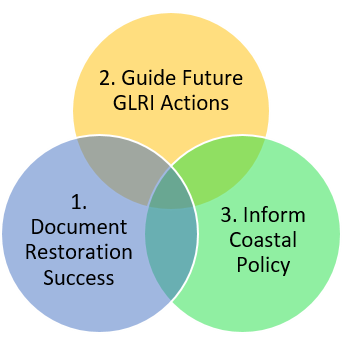Summer 2020 eNewsletter
Featured Research: Postdoctoral Research Fellow Update
Synthesizing the Great Lakes Restoration Initiative’s Funding Efforts
Dr. Matthew Jurjonas, Bailey Conservation Fellow at The Nature Conservancy and CIGLR

Dr. Matthew Jurjonas, Bailey Conservation Fellow at The Nature Conservancy and CIGLR. Photo Credit: Matthew Jurjonas.
The Great Lakes Restoration Initiative (GLRI) has funded thousands of projects since 2010 to protect and restore the largest system of fresh water in the world. These projects have been implemented by hundreds of local, municipal, state, and federal entities and span a wide range of goals and objectives. After a decade of GLRI-funded work, there is a need to compile and synthesize the actions that were performed, the effectiveness of the interventions, and the types of benefits that were found. Previous efforts to assess GLRI have primarily focused on economic analyses like return on investment calculations that consider recreation and property values. However, there is a need to expand the assessment to include equity considerations and the success of monitoring efforts. Further, as local project managers navigate the complex regulatory environment to implement projects, documenting their barriers to success could help guide future efforts.

The project’s “Data Collection and Management Plan” consists of three steps to synthesize GLRI’s funding efforts.1. Categorize all funding records using the Open Standards of Conservation; 2. Survey project managers on the level of monitoring performed and benefits found; and 3. Interview project managers to document major barriers and challenges to implementing coastal nature based solution projects. Image Credit: Matthew Jurjonas.
Matthew Jurjonas is a postdoctoral research fellow joining The Nature Conservancy and CIGLR as a Baily Conservation Fellow. “The goal of the Bailey Conservation Fellowship is to broadly assess the efforts of GLRI using the Open Standards for Conservation Action Framework, a local project manager survey, and interviews with coastal restoration project managers,” says Jurjonas.
“Currently, the efforts of GLRI are broadly categorized into toxic substances, invasive species, non-point source pollution impacts, habitats and species, foundations for future actions, and multiple focus areas,” says Jurjonas. “However, remediation and restoration efforts often involve complex planning, design, permitting, federal agreements, and engineering actions that require assessments, research, and technical assistance to successfully implement.”
Using the Open Standards of Conservation, Jurjonas will categorize these funding efforts in order to compare planning efforts to implementation actions according to the target species, contaminants, and ecosystems. His results will help guide future GLRI actions.

Dr. Jurjonas’s research goals are designed to help guide future GLRI actions and inform policy, through a synthesis of successful GLRI restoration efforts and challenges faced by local project managers when implementing restoration and remediation projects. Image Credit: Matthew Jurjonas.
“In addition, survey research will be used to measure how restoration and remediation project managers considered equity in project design, what level of monitoring was performed for ecological and human well-being indicators, and what benefits were documented,” says Jurjonas.
The next step will be for Jurjonas to engage local project managers who develop GLRI proposals that use revegetation and natural processes to protect, enhance, or restore coastal ecosystem services that mitigate wave energy and storm surge impacts. “Beyond securing funding, these managers must manage many hurdles including local zoning, siting wetland projects, and effectively monitoring the ecological condition and benefits provided by their projects over time,” says Jurjonas. “I will interview GLRI project managers to document their challenges and barriers to both implementation and monitoring, and synthesize their recommendations for streamlining the GLRI funding process and successfully implementing projects,” says Jurjonas. “Our research efforts will be used to help guide future GLRI actions and inform coastal management policy on the Great Lakes.”
Dr. Matthew Jurjonas is an environmental social scientist with a PhD from North Carolina State University. He joined the Michigan Chapter of The Nature Conservancy (TNC) and the Cooperative Institute for Great Lakes Research as a Bailey Conservation Fellow after working on the Resilient Central America project with TNC in Mexico City. His research is focused on evaluating stakeholder perceptions of nature-based solutions for coastal management on the Great Lakes, primarily in Michigan along the coast of Lake Erie.
